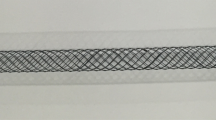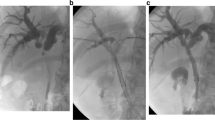Abstract
Objectives
Bilateral self-expandable metallic stent (SEMS) placement for unresectable malignant hilar biliary obstruction (UMHBO) is an effective option for biliary drainage with long-term stent patency. Laser-cut and braided SEMS can be used for bilateral SEMS placement. This study aimed to clarify any differences in the clinical features and proper use of the laser-cut and braided SEMS placement using the stent-in-stent method for UMHBO.
Methods
In this study, 78 patients who underwent bilateral stent-in-stent SEMS placement for UMHBO were included. The patients were divided into the laser-cut (n = 33) and braided groups (n = 45). Both groups were compared for technical and clinical success, adverse events (AEs), time to recurrent biliary obstruction (TRBO), overall survival, and endoscopic reintervention (ERI).
Results
There were no significant differences in technical and clinical success rates (laser-cut vs. braided group, 97% vs. 95.6%, P = 1.0), AEs (21.2% vs. 15.6%. P = 0.56), median TRBO (242 days vs. 140 days, P = 0.36), and median overall survival (654 days vs. 675 days, P = 0.58). ERI was required in 15 patients in the laser-cut group and in 20 patients in the braided group. The technical and clinical success rates of ERI (60% vs. 85%) were not significantly different (P = 0.13); however, the median ERI procedure time was significantly longer in the laser-cut group (38 min) than in the braided group (22 min; P = 0.02).
Conclusion
No significant difference in initial SEMS placement was noted between the laser-cut and braided groups; however, the laser-cut group required a longer ERI procedure time than that required by the braided group. The use of braided SEMS may be a convenient option for ERI.



Similar content being viewed by others
Abbreviations
- ABBS:
-
Angle between the bilateral self-expandable metallic stent
- AE:
-
Adverse event
- CT:
-
Computed tomography
- ERI:
-
Endoscopic reintervention
- ES:
-
Endoscopic sphincterotomy
- IHBD:
-
Intrahepatic bile duct
- IQR:
-
Interquartile range
- OS:
-
Overall survival
- RBO:
-
Recurrent biliary obstruction
- SBS:
-
Side-by-side
- SEMS:
-
Self-expandable metallic stent
- SIS:
-
Stent-in-stent
- TRBO:
-
Time to recurrent biliary obstruction
- UHMBO:
-
Unresectable malignant hilar biliary obstruction
References
Speer AG, Cotton PB, Russell RC, Mason RR, Hatfield AR, Leung JW, MacRae KD, Houghton J, Lennon CA (1987) Randomised trial of endoscopic versus percutaneous stent insertion in malignant obstructive jaundice. Lancet 2:57–62
Mukai T, Yasuda I, Nakashima M, Doi S, Iwashita T, Iwata K, Kato T, Tomita E, Moriwaki H (2013) Metallic stents are more efficacious than plastic stents in unresectable malignant hilar biliary strictures: a randomized controlled trial. J Hepatobiliary Pancreat Sci 20:214–222
Perdue DG, Freeman ML, DiSario JA, Nelson DB, Fennerty MB, Lee JG, Overby CS, Ryan ME, Bochna GS, Snady HW, Moore JP (2008) Plastic versus self-expanding metallic stents for malignant hilar biliary obstruction: a prospective multicenter observational cohort study. J Clin Gastroenterol 42:1040–1046
Lee TH, Kim TH, Moon JH, Lee SH, Choi HJ, Hwangbo Y, Hyun JJ, Choi JH, Jeong S, Kim JH, Park DH, Han JH, Park SH (2017) Bilateral versus unilateral placement of metal stents for inoperable high-grade malignant hilar biliary strictures: a multicenter, prospective, randomized study (with video). Gastrointest Endosc 86:817–827
Takenaka M, Yamao K, Minaga K, Nakai A, Omoto S, Kamata K, Kudo M (2019) Novel metallic stent designed for endoscopic bilateral stent-in-stent placement in patients with hilar malignant biliary obstruction. Endoscopy 51:e30–e31
Kogure H, Isayama H, Nakai Y, Tsujino T, Ito Y, Yamamoto K, Mizuno S, Yagioka H, Kawakubo K, Sasaki T, Hirano K, Sasahira N, Tada M, Omata M, Koike K (2011) Newly designed large cell Niti-S stent for malignant hilar biliary obstruction: a pilot study. Surg Endosc 25:463–467
Law R, Baron TH (2013) Bilateral metal stents for hilar biliary obstruction using a 6Fr delivery system: outcomes following bilateral and side-by-side stent deployment. Dig Dis Sci 58:2667–2672
Mukai T, Yasuda I, Isayama H, Nakashima M, Doi S, Iwashita T, Iwata K, Kato T, Tomita E, Moriwaki H (2011) Comparison of axial force and cell width of self-expandable metallic stents: which type of stent is better suited for hilar biliary strictures? J Hepatobiliary Pancreat Sci 18:646–652
Isayama H, Hamada T, Yasuda I, Itoi T, Ryozawa S, Nakai Y, Kogure H, Koike K (2015) TOKYO criteria 2014 for transpapillary biliary stenting. Dig Endosc 27:259–264
Cotton PB, Eisen GM, Aabakken L, Baron TH, Hutter MM, Jacobson BC, Mergener K, Nemcek A Jr, Petersen BT, Petrini JL, Pike IM, Rabeneck L, Romagnuolo J, Vargo JJ (2010) A lexicon for endoscopic adverse events: report of an ASGE workshop. Gastrointest Endosc 71:446–454
Okuno M, Mukai T, Iwashita T, Ichikawa H, Iwasa Y, Mita N, Yoshida K, Iwata K, Tomita E, Shimizu M (2019) Evaluation of endoscopic reintervention for self-expandable metallic stent obstruction after stent-in-stent placement for malignant hilar biliary obstruction. J Hepatobiliary Pancreat Sci 26:211–218
Takahashi E, Fukasawa M, Sato T, Takano S, Kadokura M, Shindo H, Yokota Y, Enomoto N (2015) Biliary drainage strategy of unresectable malignant hilar strictures by computed tomography volumetry. World J Gastroenterol 21:4946–4953
Vienne A, Hobeika E, Gouya H, Lapidus N, Fritsch J, Choury AD, Chryssostalis A, Gaudric M, Pelletier G, Buffet C, Chaussade S, Prat F (2010) Prediction of drainage effectiveness during endoscopic stenting of malignant hilar strictures: the role of liver volume assessment. Gastrointest Endosc 72:728–735
Naitoh I, Ohara H, Nakazawa T, Ando T, Hayashi K, Okumura F, Okayama Y, Sano H, Kitajima Y, Hirai M, Ban T, Miyabe K, Ueno K, Yamashita H, Joh T (2009) Unilateral versus bilateral endoscopic metal stenting for malignant hilar biliary obstruction. J Gastroenterol Hepatol 24:552–557
Lee TH, Moon JH, Choi JH, Lee SH, Lee YN, Paik WH, Jang DK, Cho BW, Yang JK, Hwangbo Y, Park SH (2019) Prospective comparison of endoscopic bilateral stent-in-stent versus stent-by-stent deployment for inoperable advanced malignant hilar biliary stricture. Gastrointest Endosc 90:222–230
Naitoh I, Hayashi K, Nakazawa T, Okumura F, Miyabe K, Shimizu S, Yoshida M, Yamashita H, Ohara H, Joh T (2012) Side-by-side versus stent-in-stent deployment in bilateral endoscopic metal stenting for malignant hilar biliary obstruction. Dig Dis Sci 57:3279–3285
Kawakubo K, Kawakami H, Toyokawa Y, Otani K, Kuwatani M, Abe Y, Kawahata S, Kubo K, Kubota Y, Sakamoto N (2015) Risk factors for technical failure of endoscopic double self-expandable metallic stent placement by partial stent-in-stent method. J Hepatobiliary Pancreat Sci 22:79–85
Kawai J, Ogura T, Takenaka M, Shiomi H, Ueshima K, Ueno S, Okuda A, Matsuno J, Minaga K, Omoto S, Nakai A, Ikegawa T, Hakoda A, Higuchi K (2022) Prospective multicenter evaluation of moving cell metallic stents in endoscopic multiple stent deployment for hepatic hilar obstruction. J Hepatobiliary Pancreat Sci 29:1195–1203
Kawamoto H, Tsutsumi K, Fujii M, Harada R, Kato H, Hirao K, Kurihara N, Nakanishi T, Mizuno O, Ishida E, Ogawa T, Fukatsu H, Sakaguchi K (2007) Endoscopic 3-branched partial stent-in-stent deployment of metallic stents in high-grade malignant hilar biliary stricture (with videos). Gastrointest Endosc 66:1030–1037
Kawamoto H, Tsutsumi K, Harada R, Fujii M, Kato H, Hirao K, Kurihara N, Nakanishi T, Mizuno O, Ishida E, Ogawa T, Fukatsu H, Sakaguchi K (2008) Endoscopic deployment of multiple JOSTENT SelfX is effective and safe in treatment of malignant hilar biliary strictures. Clin Gastroenterol Hepatol 6:401–408
Kim KM, Lee KH, Chung YH, Shin JU, Lee JK, Lee KT, Shim SG (2012) A comparison of bilateral stenting methods for malignant hilar biliary obstruction. Hepatogastroenterology 59:341–346
Lee TH, Moon JH, Kim JH, Park DH, Lee SS, Choi HJ, Cho YD, Park SH, Kim SJ (2013) Primary and revision efficacy of cross-wired metallic stents for endoscopic bilateral stent-in-stent placement in malignant hilar biliary strictures. Endoscopy 45:106–113
Kato S, Kuwatani M, Onodera M, Kudo T, Sano I, Katanuma A, Uebayashi M, Eto K, Fukasawa M, Hashigo S, Iwashita T, Yoshida M, Taya Y, Kawakami H, Kato H, Nakai Y, Kobashigawa K, Kawahata S, Shinoura S, Ito K, Kubo K, Yamato H, Hara K, Maetani I, Mukai T, Shibukawa G, Itoi T (2022) Risk of pancreatitis following biliary stenting with/without endoscopic sphincterotomy: a randomized controlled trial. Clin Gastroenterol Hepatol 20:1394–1403.e1391
Kato H, Tsutsumi K, Kawamoto H, Okada H (2015) Current status of endoscopic biliary drainage for unresectable malignant hilar biliary strictures. World J Gastrointest Endosc 7:1032–1038
Takenaka M, Nakai A, Kudo M (2020) Novel concept of bared type metallic stent for endoscopic bilateral stent-in-stent placement in patients with hilar malignant biliary obstruction (with video). J Hepatobiliary Pancreat Sci 27:282–283
Funding
This work was supported by JSPS KAKENHI (Grant Number JP23K14646).
Author information
Authors and Affiliations
Contributions
Conceptualization, methodology, formal analysis: MO, KI, TM. Investigation: MO, YO, SI, YI, KY, AM, RT, Hironao Ichikawa, NM, SU, Writing original draft preparation: MO. Writing review and editing: KI, TM. Supervision: TI, ET, MS.
Corresponding author
Ethics declarations
Disclosures
Mitsuru Okuno, Keisuke Iwata, Tsuyoshi Mukai, Yosuke Ohashi, Shota Iwata, Yuhei Iwasa, Kensaku Yoshida, Akinori Maruta, Ryuichi Tezuka, Hironao Ichikawa, Naoki Mita, Shinya Uemura, Takuji Iwashita, Eiichi Tomita, and Masahito Shimizu have no conflicts of interest or financial ties to disclose.
Additional information
Publisher's Note
Springer Nature remains neutral with regard to jurisdictional claims in published maps and institutional affiliations.
Rights and permissions
Springer Nature or its licensor (e.g. a society or other partner) holds exclusive rights to this article under a publishing agreement with the author(s) or other rightsholder(s); author self-archiving of the accepted manuscript version of this article is solely governed by the terms of such publishing agreement and applicable law.
About this article
Cite this article
Okuno, M., Iwata, K., Mukai, T. et al. The evaluation of bilateral stenting using braided or laser-cut self-expandable metallic stent for malignant hilar biliary obstruction. Surg Endosc 37, 8489–8497 (2023). https://doi.org/10.1007/s00464-023-10457-4
Received:
Accepted:
Published:
Issue Date:
DOI: https://doi.org/10.1007/s00464-023-10457-4




